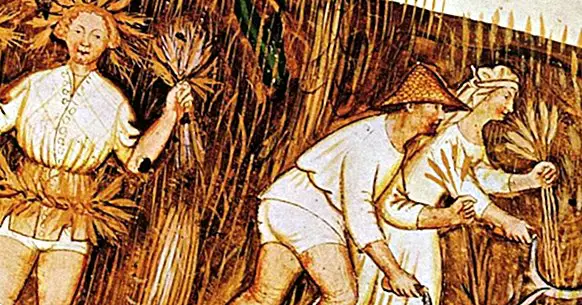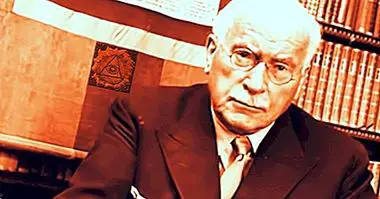Feudalism: what it is, stages and characteristics
Feudalism is an important part of the history of social organizations in the West . As such, these organizations are made up of political and economic elements that are complex and closely related to the social structure. That is, there is a hierarchy where one or more modes of production are related to social superstructures such as politics or the State.
In the case of the feudal system, what is at the bottom is the intention to ensure the survival of the warrior caste. For this, it will be the peasants or servants who will defray the expenses of those who fight. In medieval Europe, the latter occurs through a stately system that organizes a complex network of loyalties and obligations in a chain of production, whose highest link is the crown and the lowest the serf.
In this article we will see what is feudalism, what are its antecedents and development , as well as some of the main features.
- Related article: "Middle Ages: the 16 main characteristics of this historical stage"
What is feudalism?
Feudalism is the social system that dominated Western Europe and its colonies during the Middle Ages , specifically from the VIII century until the XV, and was expanded by the Carolingian dynasty.
Broadly speaking, his organization consists of the following: in exchange for the oath of fidelity and military service, the king gives a piece of land to a vassal, who is part of the nobility.
Without having the right to property and without committing to inherit this land, the vassals acquire the possibility of using and managing it. This contractual relationship is known as "vassalage" and the tribute that is given in exchange for the right to land is called "feudal tenure." The person in charge of managing this tenure and representing feudal relations is called "tenente".
The territory in question is worked by the peasants (called serfs), who were forced to live on the same land and paid homage to the owner by providing a part of the product worked. They received in return the promise of military protection.
- Maybe you're interested: "The 5 ages of History (and its characteristics)"
Brief history: from the Roman Empire to the final crisis
Like all social systems, feudalism followed a historical trajectory, at the economic as well as the political and social levels. In the economic dimension, this trajectory began with taxes and advanced to trade; in politics it was developed through a centralized monarchy, and in the social it was structured by castes that went from the clergy and the army , until finally the bourgeoisie.
Considering that the latter developed in different ways in each territory, we will see below a review of what happened in Western Europe.
Background and development
In the V century falls the empire that had dominated Western Europe since the first century: the Roman Empire. The territory stops being unified and it is divided into the Roman Empire of the East and the Western Roman Empire . The first advances culturally and intellectually along with the institutionalization of Christianity, and ends until the fall of Constantinople in the fifteenth century.
The second one was destroyed several centuries before, as a consequence of the barbarian invasions that allow the final transition towards the Middle Ages. The previous thing happened after numerous wars that took place in the 5th and 6th centuries, which, among other things, generated an increase in the number of slaves.
Far from joining the traditional slave estates that were characteristic of Roman antiquity, many of these slaves became free tenants. However, before the collapse of the haciendas, many of them were dispersed in the different holdings, leading to servitude . This represents one of the beginnings of feudalism.
But already in Ancient Rome they began to generate production relationships based on the tax or the tax imposed by the owners of a subject field. The analysis of the more classical planet feudalism emerged from a relationship based on servitude and coercive political authority exerted by the tenants and the lordship inaugurated in the Middle Ages as a result of the expansion of slavery.
However, other perspectives add that in the late Roman Empire there was already a society that was beginning to be dominated by the feudal mode of production, based on the payment in kind of a land tax , which subsequently became an income.
The Carolingian dynasty
It was the representative of the Carolingian dynasty, Carlos Martel, who at the end of the 8th century gave his nobles some rights over the land, so that he could ensure the income necessary to maintain the army .
In exchange for this, the noble or vassal would have to pay tribute and gratitude. This exchange is called "fief", and the owner "feudal lord" . This allows the development of a relationship between the lord and the vassal, as well as the expansion of the feudal pyramid.
Feudalism finally settled in the tenth century, while the aristocracy is in close relationship with Christianity. In this context the pope has special powers and privileges as God's representative on earth, and it is precisely the papacy who at the end of the 12th century has the greatest number of feudal vassals.
Crisis and decline
Over the centuries, feudalism became an abusive, rigid and very complex system. Its original structure, where a chain of allegiances and personal relationships used to be generated, begins to become a centralized monarchy .
Among other things, feuds begin to be inherited, which causes the links between vassal and lord to be lost. Religious institutions and the high clergy take administrative, economic and military power; the kings use the feudal organization to stay at the top of the pyramid.
In addition, the military protection that was previously granted, begins to be replaced by monetary exchange ; which opened the door to commerce. The development of infantry weapons and agricultural techniques made it impossible to establish relations based on war, and allowed to establish relationships more based on economic development.
Finally feudalism as a social, political and economic system decays from armed conflicts such as the crusades; and health conflicts such as the appearance of serious diseases such as pests. This was compounded by the erosion of farmland, along with the increase in the possibilities of leasing land that gave more independence to the peasantry , as well as the opening of new routes that generate migration and population growth.
Bibliographic references:
- Wickham, C. (1989). The other transition: from the ancient world to feudalism. Historical Studia. Medieval history 7: 7-36.
- History World. (S / A). History of feudalism. Retrieved July 25, 2018. Available at //www.historyworld.net/wrldhis/PlainTextHistories.asp?ParagraphID=eny.



















